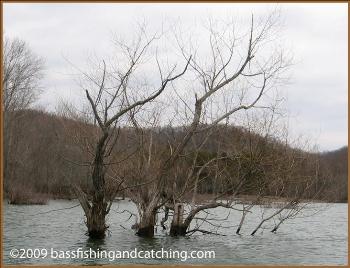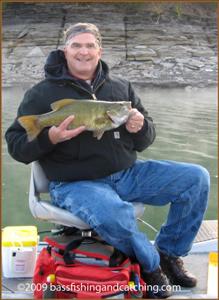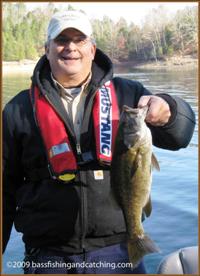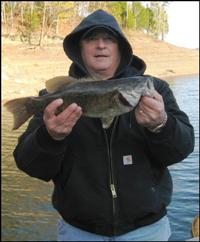Winter Bass Fishing
Invigorates The Body and Clears The Mind
Really, I'm Serious!
Winter bass fishing. Just the thought makes many shudder. Trees barren of leaves, overcast skies, cold air, cold sometimes blustery wind and cold water. Cold hands, cold head, runny nose and cold feet. Worst of all, no fish!!!! "No way I'm going out there.", says you.


Not so fast! Gather round fellas and listen up. Winter bass fishing, the months of December, January and February, and can reward you with not only numbers of bass, but possibly some of the biggest fish you'll ever catch.
Those of you who live in the northern tier of states must suffer through tougher winters than those of us down South or out West. Many of you even have "freeze over" to contend with. Perhaps some of you ice fish. A subject on which I am woefully unqualified to opine. However, it does seem to be a great excuse for sitting around eating fattening food and drinking a few brews.
But when it comes to just "cold water" bass fishing we Bass Bums® in the southern states, at least those few who prefer bass fishing to sitting on our butts watching football every weekend (blessed be the DVR), can speak well to the subject of winter bass fishing, when the water is in the 40's and low 50's. Personally I'd rather fish in winter than the middle of summer. There are fewer pleasure boaters, skiers and jet skiers (somebody get me a gun) and also fewer bass fishermen.

Before we get started let's dispel some common misconceptions about winter bass fishing.
- Bass don't feed in winter. UNTRUE! They do not feed as often but they do feed all winter long, though they eat more in early winter than late winter after food sources and energy reserves have dwindled. They do eat and they do so efficiently. In 80 degree water a bass digests its food in about four hours. In 50 degree water it takes about four days. They don't chase food as enthusiastically as they do in spring because their energy levels are low. Their body temperature, bass being cold blooded, is the same as the surrounding water, usually in the 40's. Listen, if your body temperature dropped that low you wouldn't be just slow, you would be dead. But, because the baitfish and other foods are also slow in winter they don't have to engage in energy draining pursuits of prey.
- Bass are always deep, deep in winter. UNTRUE!
- Largemouth bass bunch up in winter. TRUE!
- You must fish sloooooowww when winter bass fishing. USUALLY TRUE, BUT NOT ALWAYS!

Winter Is (Can Be) A Dangerous Time To Be On The Water!
Stay Warm and Dry
The first consideration is to dress appropriately for winter bass fishing. If you say, "I'll just freeze my butt off if I go", is to make an excuse when there isn't one.
Today's many innovative materials such as Gore-tex, Thinsulate and the technology of Under Armour's Cold Gear in undergarments, plus great jackets, pants, bibs and overalls insure you can go winter bass fishing in comfort. Great winter clothing made with these materials are available from companies like Bass Pro, Diluth, Under Armour and Carhartt to name but a few.

Remember Safety!
Next consideration is to wear a reliable life jacket, at least when running across the lake. I know, I know, they're bulky, constraining and a general pain in the butt. But the new hydrostatic "inflator" models from Mustang and other companies are thin and lightweight.
It's a good idea, especially when winter bass fishing, to wear one all the time. We all know guys fall in every year and some drown. If you should fall in water 50 degrees or colder your body is going to get a heck of a shock. It will literally take you breath away. If you fall in 50° water you have a 50% chance to survive 50 minutes!
I Speak From Experience.
A couple of winters ago, when fishing Dale Hollow Lake, I laid a rig consisting of a $325 G.Loomis rod and $650 Shimano reel on my deck while dragging a big shiner. It was literally jerked into the water from the deck of my boat by a strike from what was probably a muskie. I had saved a long time to buy that rig and I wasn't going to let it go to the bottom.
So, in I go after it without a thought. No life jacket. I managed to grab the rig but lost a $700 pair of glasses and damn near drowned in the process. I'm 6'4" and 250 pounds. My fishing partner was 5'7" and 140 pounds. Getting back in the boat was a major deal. If I had been alone it may have turned out badly. Wear a life jacket!
Have Food and Drink Always
Lastly, stay hydrated. Make sure to have water and food with you. You can get dehydrated in cold weather just as easily as in hot weather. To keep your energy level up drink water and have some form of protein and high energy food in the boat. Beef jerky and granola bars for example.

Now, To The Fishing and Catching Part of Winter Bass Fishing
Where Are The Bass?
Just Look For Stable Water Conditions.
Water "stability" is water that experiences minimal or no rapid or significant change to water temperature, water clarity, oxygen saturation of the water or water pH. Bass, especially largemouth bass, will gather in those areas of a body of water which experience the least amount of change to these environmental conditions. In fact, any time there is a "stable" period of weather in winter you can reasonably expect some bass to get active in shallow (6-10') water, especially if there are any remnants of weeds around.
Where do you find these "stable" areas? Where is there the least impact from storms and the affect they have on water temperature, either up or down, and water clarity? We're not including "cold" water here. It's not about cold water. It's about stable water be it cold, cool or warm. The worst the typical weather conditions are throughout the winter months, where you fish, the greater the tendency of bass to "group up" in spots least impacted by this weather. In fact, when you find winter bass you will often find a lot of them in one spot.
Those of you who fish in southern reservoirs know that water stability is fleeting in them. They're raised and lowered continually for purposes of flood control or power generation. They rise faster after heavy rains, and they have a mind boggling topography from their shallow upper end to their downstream end close to the dam. All this contributes to a relatively unstable environment for bass and a complicated equation for bass anglers trying to find bass.
There is a silver lining though. Reservoirs have more shoreline, more deep and shallow water, more structure, more open-water, and more diverse forms of cover. They often hold both largemouth and smallmouth in good numbers. Generally, bass will remain shallow till the water reaches 50° at which time they will start moving deeper holding up on points and dropoffs.
Deep Water
Deep water is where
these conditions of stability are usually found and that is where you
will find the bass. Remember, deep is relative to whether you're on a
natural northern lake, a deep southern reservoir, a river or a farm
pond.
Look For Cover and Structure In Deep Water
Studies show that in the north, where there are mostly natural lakes, which tend to be more shallow overall than southern highland reservoirs, some weeds can be found even in winter. Largemouth bass will be found around this grass, sickly though it may be, in "deep" (12-15') water. This is especially true if the grass is close to even deeper water. If the water is particularly clear you may find grass as deep as 40'. Panfish make up a good bit of northern bass' diet as do crawfish, both of which can be found around remaining grass. Northern strain bass will remain active even in water that is in the upper 30's and low 40's where southern reservoir bass will sometimes become practically comatose.

In the southern hill-land and highland reservoirs there is little, if any, grass. Bass will gravitate instead to deeper wood cover such as timber, stumps and logs where they will bunch up. It's the same kind of "cover" they might use in spring only deeper.
You will find when winter bass fishing that bass will also bunch up around the same type structure as they do in spring only deeper. For example, points, humps, drop offs, bluffs and creek channels. The common denominator that attracts bass to these features is the presence of steep vertical drops and baitfish. Look for the schools of shad suspended over this type "structure" and you'll find bass close by. Key in on the shad first and then the structure. The bass will not necessarily be right on the structure but just "off" it anywhere from 20-50'.
Also, since most water in Southern reservoirs does not freeze over, bass can be found keying on schools of shad suspended 10-15' down over open water 30-50'deep.

OK, You've Found Them
Now What Are The Lures And Techniques To Catch Them With?
Cold Water Bass Fishing Lures Overview
Don't think there are but two or three lures that work well for winter bass fishing. The lures you use in spring and fall are the same for winter. It's the way you fish them that is different.
- Jerkbaits - The key to fishing jerkbaits when winter bass fishing is to not jerk them! Cast it, reel down to its max depth then just let it sit!
- Jig and Pig - is hard to beat when the water drops to 40°
- Spinnerbaits - are best when fished shallow with a slow roll retrieve. Use them parallel to bluffs, around logs, stumps and grass.
- Jigging Spoons - are an excellent winter bass fishing lure. Drop it down below suspended fish or to the bottom if bass are holding there, pause it then lift your rod tip about 2-3 feet. Don't jerk so hard you dislocate your shoulder. Just lift it up with a quick snatch then drop it about a foot, then 2-3 feet upwards again repeating until you have it well past the depth of the fish.
- Deep Diving Crankbaits - see deep diving crankbaits
- Plastics - include worms both Texas and Wacky rigged and for largemouth in early winter big 10" worms and lizards get whacked. Grubs are good for both smallmouth and largemouth as they are small, fitting the reduced appetites of winter bass, and realistic in action.
- Live Bait - use Gamakatsu shiner hooks and don't let the fish "run" after striking or they'll swallow the hook. Count to three "at the most" and set the hook. With these hooks you'll miss very few. I set the hook as soon as I feel the strike, no hesitation. I've missed maybe one out of 50 using these hooks with shiners.
Lure Size And Presentation
Big Or Small?
Until the water gets to the below 50° use lures when winter bass fishing that represent the size of baitfish that have grown a full season, even larger. However, once the water drops into the 40's downsize your lures. The bass now have a much slower metabolism and energy level. Their need for food drops significantly and they will feed far less, but they will feed. They will take anything that is smaller and appears easy to catch, even the big hawgs. Thus, the reason bigger bass are caught during winter months. Focus on lures that are no bigger than 3-4". Small jigs like the Strike King "Bitsy Bug" or the Eakins Jig with 3" trailers can't be beat.
Fast Or Slow?
Though some will tell you that when they are winter bass fishing they fish just as fast as they do in spring overwhelming evidence points to slowing way down when presenting your lures. As a general rule bass won't chase lures in water that is in the 40's. Their are exceptions, like when bass move up shallow after a string of unusually warm days, but most of the time slow down your presentation.

How To Catch Largemouth Bass Winter Bass Fishing
On deeper, clear lakes largemouth as well as their baitfish prey tend to bunch up around vertical structure (bluffs) and offshore structure (humps, sunken islands, rock piles) in "deeper" water, deeper being 20-40' deep. The theory is that bass can move more easily and with less expenditure of energy to change their depth. Additionally, the bluff wall and vertical walls around sunken islands, is a maze of rock outcroppings, boulders, cuts and ledges. All features loved by bass as ambush points.
How to fish these bluffs? First tie on a jig and pig (or plastic trailer). cast this to the bluff wall then methodically work it slowly downward from step to step. I've had much success with a wacky rigged Senko cast up to the wall and allowed to slowly sink down the bluff face. Slow rolling, and I emphasize slow, a spinnerbait parallel to a bluff can also be productive after a series of warmer winter days. On such days bass may move up to as shallow as five feet along the bluff wall. Slowly work a jerkbait (include long pauses or dead sticking it) or lipless crankbait parallel to the bluff wall as well.
Largemouth bass can also be found bunched up around offshore structure like humps or the point ends of bluffs when winter bass fishing. Target the end of bluff points with jigs. Use jigging spoons and drop-shot rigs for vertical fishing offshore humps and channel breaks. Channel banks that intersect are good places to find largemouth. If you find any remaining grass don't pass it up. Pull out a lipless crankbait and slowly work the grass edges and top or toss in a jig.
"Shallow" Winter Largemouth Pattern
This is primarily a largemouth pattern. Not all baitfish leave creeks for deeper water in late fall. Some will remain there through the winter and serve to keep some largemouth there which prey on them. After several days of winter rain the inflow of water in the back of creeks creates stained water. Once the sun comes out, this stained water warms more than main lake water. This warmth stimulates the baitfish to be more active and in turn largemouth move to feed on them.
Look for wood cover like stumps, logs and brush to hold bass. Also, if there is any remaining grass in a deep hole in the creek you will very likely find some bass there. Work these different covers with jigs and crankbaits.

How To Catch Smallmouth Bass Winter Bass Fishing
The consensus among successful smallmouth fishermen is that the optimum winter bass fishing conditions for catching smallmouth are:
- Air temperature upper 30's to mid 40's
- Overcast skies
- Threat of rain or snow. Smallmouth love the snow, go figure.
- Water temperature between 45-55°, depending on the lake.
You'll find smallmouth holding on or suspending just off bluff walls when you're winter bass fishing. They will also be found on less conspicuous, less fishy looking banks. These are banks that are characterized by gravel and small chunk sized rock and those with mud mixed with smaller rock. These are the type banks that draw crawfish to winter over and of course from which they emerge in spring. The smalljaws are likely there with them. Gradually sloping 45° banks that run out to a main channel drop off are smallmouth attractors. They may not always be right on these banks but are also likely to be suspended over the dropoff in 40' or more of water.
Downsized Smallmouth Lures For Winter Bass Fishing
Good choices are grubs, jig and craw, smaller spinnerbaits and crankbaits, Whirley Bee/Jimmy D, Sliders, tube jigs or Texas rigged, 4" straight worms like the Senko, and 1/16 ounce synthetic craft hair or duck feather jigs when Float-n-Fly fishing.
Return To Fishing For Bass From Winter Bass Fishing
